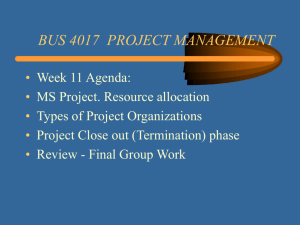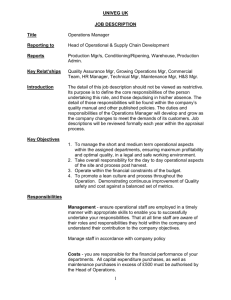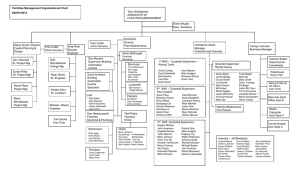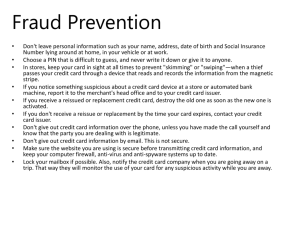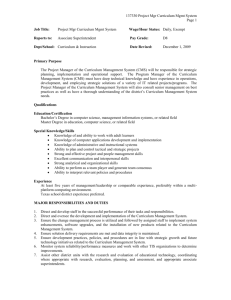Haggle Work - The Computer Laboratory
advertisement
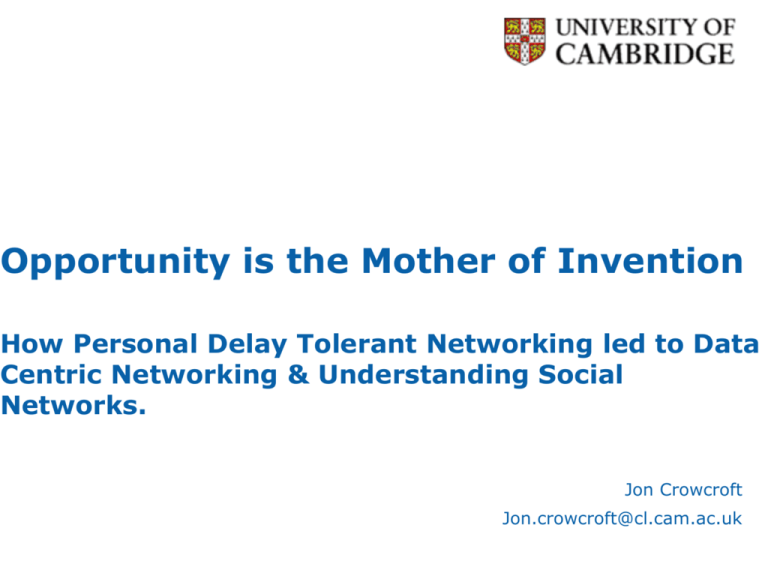
Opportunity is the Mother of Invention
How Personal Delay Tolerant Networking led to Data
Centric Networking & Understanding Social
Networks.
Jon Crowcroft
Jon.crowcroft@cl.cam.ac.uk
Outline Narrative History of Haggle
1. Haggle Software Architecture
2. How we got to Declarative Data Driven Nets
3. Why we got diverted into Social Networks
Thank you but you are in
the opposite direction!
I have 100M bytes of
data, who can carry
for me?
I can also carry for
you!
Give it to me, I have
1G bytes phone flash.
Don’t give to me! I
am running out of
storage.
Reach an access
point.
There is one
in my
Search La
pocket…
Bonheme.mp3 for
me
Internet
Finally, it
arrive…
Search La
Bonheme.mp3 for
me
Search La
Bonheme.mp3 for
me
1. Motivation 2001-2004
• Mobile users currently have a very bad experience with
networking
•
Applications do not work without networking infrastructure such
as 802.11 access points or cell phone data coverage
•
Local connectivity is plentiful (WiFi, Bluetooth, etc), but very
hard for end users to configure and use
• Example: Train/plane on the way to London
•
•
How to send a colleague sitting opposite some slides to review?
How to get information on restaurants in London? (Clue:
someone else is bound to have it cached on their device)
• Ad Hoc Networks were a complete washout
•
•
Failed to account for heavy tailed density distribution
Use of 802.11 as radio was at best misguided.
Underlying Problem
• Applications tied to network details and operations
via use of IP-based socks interface
• What interface to use
• How to route to destination
• When to connect
• Apps survive by using directory services
• Address book maps names to email addresses
• Google maps search keywords to URLs
• DNS maps domain names to IP addresses
• Directory services mean infrastructure
Phase transitions and networks
• Solid networks: wired, or fixed wireless mesh
•
•
Long lived end-to-end routes
Capacity scarce
• Liquid networks: Mobile Ad-Hoc Networking (MANET)
•
•
Short lived end-to-gateway routes
Capacity ok (Tse tricks with power/antennae/coding)
• Gaseous networks: Delay Tolerant Networking (DTN), Pocket
Switched Networking (PSN)
•
•
•
•
No routes at all!
Opportunistic, store and forward networking
One way paths, asymmetry, node mobility carries data
Capacity Rich (Grossglauser&Tse) (but latency terrible… … …)
• Haggle targets all three, so must work in most general case,
i.e. “gaseous”
Decentralisation&Disconnectivity
• Absence of infrastructure for
• Routing, searching, indexing
• Names, Identity, Currency
• When everything’s adhoc, even pagerank has to be
• Hence “Ad Hoc Google” -> “Haggle” Intel Cam 2004.
• Bad joke about french pronunciation of “Haddock”
• As
•
•
•
early pub/sub systems, interest itself is data
So we take event/notify+pub/sub and apply to
Discovery of users, nodes, routes, interest
everyone soaks it all up and runs ego-centric pagerank
Current device software framework
File System
User Data
App logic + GUI
Application
Isolated from
network
App has two
orthogonal parts
Protocol
Networking
Delivery (IP)
Synchronous,
node-centric API
Interfaces
Delivery uses
anonymous IP
Haggle framework design
Applications
App Logic + GUI
Less work for new
app developers
Not tied to one app;
exposed metadata
Haggle
Resource
Mgmt
Protocols
Asynchronous,
data-centric API
Key component
missing before
Interfaces
Multiple protocols
usable for each task
Data Objects (DOs)
• DO = set of attributes = {type,
value} pairs
•
Exposing metadata facilitates
search
•
Another bad (Diot) joke
• Can link to other DOs
•
To structure data that should be
kept together
•
To allow apps to
categorise/organise
• Apps/Haggle managers can
“claim” DOs to assert ownership
Message
DO-Type
Data
Content-Type
message/rfc822
From
James Scott
To
Richard Gass
Subject
Check this photo out!
Body
[text]
Attachment
DO-Type
Data
Content-Type
image/jpeg
Keywords
Sunset, London
Creation time
05/06/06 2015 GMT
Data
[binary]
DO Filters
• Queries on fields of data objects
• E.g. “content-type” EQUALS “text/html” AND
“keywords” INCLUDES “news” AND “timestamp”
>= (now() – 1 hour)
• DO filters are also a special case of DOs
• Haggle itself can match DOFilters to DOs – apps
don’t have to be involved
• Can be persistent or be sent remotely…
DO Filter is a powerful mechanism
Local
Remote
One-Off
Persistent
“Desktop” Search
Listen
(find mp3s with
artist “U2”)
(wants to receive
webpages)
“Web” Search
Subscribe
(find “london
restaurants”)
(send all photos created by
user X to X’s PC)
Layerless Naming
• Haggle needs just-in-time binding of user level
names to destinations
• Q: when messaging a user, should you send to
their email server or look in the neighbourhood for
their laptop’s MAC address?
• A: Both, even if you already reached one. E.g. you can
send email to a server and later pass them in the corridor,
or you could see their laptop directly, but they aren’t
carrying it today so you’d better email it too…
• Current layered model requires ahead-of-time
resolution by the user themselves in the choice of
application (e.g. email vs SMS)
Name Graphs comprised of Name
Objects
• Name Graph represents full variety
of ways to reach a user-level name
DO-Type
Name
• NO = special class of DO
Name
James Scott
• Used as destinations for data in
transit
• Names and links between names
obtained from
•
•
•
•
•
Applications
Network interfaces
Neighbours
Data passing through
Directories
DO-Type
Name
Name
00:0E:F6:23:91:34
DO-Type
Name
Name
jamesscott@acm.org
Forwarding Objects
• Special class of DO used for
storing metadata about
forwarding
•
TTL,expiry, etc
• Since full structure of
naming and data is sent,
“intermediate” nodes are
empowered to:
•
•
FO
DO
DO
Use data as they see fit
Use up-to-date state and
whole name graph to make
best forwarding decision
NO
DO
DO
NO
NO
NO
Connectivities and Protocols
• Connectivities (network interfaces) say which
“neighbours” are available (including “Internet”)
• Protocols use this to determine which NOs they
can deliver to, on a per-FO basis
• P2P protocol says it can deliver any FO to neighbourderived NOs if corresponding neighbour is visible
• HTTP protocol can deliver FOs which contain a DOFilter
asking for a URL, if “Internet” neighbour is present
• Protocols can also perform tasks directly
• POP protocol creates EmailReceiveTask when Internet
neighbour is visible
Forwarding Algorithms
{Protocol, Name, Neighbour}
FOs
x
x
x
xx
x
x
x
algorithm 1
algorithm 2
x = scalar
“benefit” of
forwarding task
• Forwarding algorithms create Forwarding Tasks to
send data to suitable next-hops
• Can also create Tasks to perform signalling
• Many forwarding algs can run simultaneously
Aside on security etc
• Security was “left out” for version 1 in this 4-year EU project,
but threats were considered
• Data security can reuse existing solutions of
authentication/encryption
•
With proviso that it is not possible to rely on a synchronously
available trusted third party
• Some new threats to privacy
•
•
Neighbourhood visibility means trackability
Name graphs could include quite private information
• Incentives to cooperate an issue
•
Why should I spend any bandwidth/energy on your stuff?
• Did address later (Social Nets 2009-2011)
•
see safebook.us by Eurecom folks…
Haggle S/W Architecture Details #1
• Motivation for doing mobile networking differently
• Problem definition for mobile networking: “Pocket
Switched Networking”
• A set of guiding principles behind our PSN solution,
named Haggle
• A 39000 feet overview of Haggle’s initial desig
Motivation: Mobile users currently have
a very bad experience of networking
• Applications do not work without infrastructure
• Local connectivity is plentiful (WiFi, Bluetooth, etc),
but very hard to use transparently
• E.g. messaging/file transfer to others in this room?
• E.g. If I had used a modem to get some cached
web content (e.g. news) earlier, and you wanted to
access it, how can we share it?
The wireless networking research community has
failed to support our end users
Pocket Switched Networking (PSN):
Scenario for Mobile (DTN) Humans
• Study/define problem before attempting solution
• Pocket Switched Networking: the scenario that the
mobile user of consumer IT apps faces every day
• Humans carry one or more devices with them, each with
wireless networking capabilities and storage
• These devices experience neighbourhood (e.g. Bluetooth)
and infrastructure (e.g. 802.11 AP) connection
opportunities (with differing bandwidths, costs, etc)
• Human mobility generates these opportunities as they
move around with their normal mobility patterns.
Pocket Switched Networking:
Application traffic
• In PSN, we can identify two classes of application traffic:
known-sender where one node needs to transfer data to a user-level
destination (not a network-level address), e.g.:
•
•
•
Another user (who may own many nodes)
All users in a certain place/with a certain interest
Users with a certain role (e.g. “police”), etc.
known-recipient in which a device requires content of some sort, but it
is irrelevant where the data comes from, e.g.:
•
•
•
Publicly distributed content such as “current news webpage”
Media files, e.g. “songs by the Scissor Sisters”
Locally generated information, e.g. traffic news
• For known-sender, there may be many recipients; for knownrecipient, there may be many sources.
• Yes, it’s very Pub/Sub (therefore CCN/NDN/PSIRP/LIPSIN etc)
Why status quo (IP) does badly in PSN
• IP doesn’t handle many-recipient well, and does not handle
many-source at all
• IP’s strict layering means infrastructure lookups to find
endpoint addresses before data transmission begins
• TCP/IP’s stream abstraction means that apps have to
implement app-layer protocols; these rely on access to
specific infrastructures
•
E.g. email user wants “message to James” but email client
implements “message to IP address of MX DNS record of
James’s email domain”
• IP cannot handle non-contemporaneous connectivity, e.g. use
of human mobility as data transfer opportunity
• Packet switching means that app-layer data is lost to the
network; further exchanges of the same data means insertion
of the data into the network by an application
Design principles for Haggle
A. Forward using application layer information
B. Asynchronous operation
C. Empower intermediate nodes
D. Message switching
E. All user data kept network-visible
F. Build request-response into the network
G. Exploit all data transfer methods
H. Take advantage of brief connection opportunities
I. Empowered and informed resource management
J. Use and integrate with existing application infrastructure
where possible
A. Forward using application layer
information
• Use names meaningful to apps, e.g. human names,
keywords for documents, parameters for content
wanted (mime-type, etc)
• Delivery of data is accomplished by using the data
itself to choose forwarding path, rather than
artificial meaningless-to-the-user addresses such
as IP.
B. Asynchronous operation
• Apps can indicate network actions when natural to
them; actual transfers can happen asynchronously
when suitable connectivity occurs
• Late binding of user-level names to network-level
addresses means that up-to-date context
information can be used, e.g. dynamic IP address
• Support non-contemporaneous, store-and-forward
connections
C. Empower intermediate nodes
• Much content is public/sharable – e.g. webpages
• Thus any intermediate node may also be a valid
destination, e.g. it’s user might also be interested
in the webpage later
• Additionally, the intermediate node can be a
source for that data too – e.g. it meets another
node who is interested in the webpage
D. Message switching
• Message switching is useful for principles A,B,C
• Application layer forwarding information applies to
whole messages
• With variability inherent in non-contemporaneous
data paths, packet switching would result in lots of
useless half-messages arriving, wasting bandwidth
• Intermediate nodes cannot gain benefits unless
entire data units are made available to them
• Aside - looks like DTN Bundles but it isn’t
E. All user data kept network visible
• Data should not be stored privately by applications, but kept
in the Haggle framework where it can be shared with other
devices.
• Even your most personal data can be shared – with your
other devices. Encryption can be used to prevent
unauthorised parties snooping.
•
Painful data synchronisation systems (e.g. phone/PC) can be
made obsolete!
• Public data is often popular and duplicated locally, so making
this visible allows us to find more sources for it
•
{Looks a bit like all browsers are p2p or caches/proxies also}
• Think original IP arch + plutarch
F. Build request-response into the
network
• User-level tasks are sometimes inherently two-way,
e.g. a request for content and the response
including the content
• Supporting this in the network framework itself
rather than in apps allows all nodes to be used for
the “turnaround point”
• I.e. all nodes can cache application data (even if
they do not run any app that can understand it),
and respond to a request for that data
G. Exploit all data transfer methods
• Different transfer methods have different
properties
• Synchronous (Bluetooth), asynchronous (SMS)
• Zero cost (neighbourhood), cost-per-hour (WiFi hotspot),
zero cost till monthly limit hit (SMS)
• Physical-layer bandwidths, latencies, loss rates, etc
• A given transmission may be sent using multiple
diverse paths, e.g. by email and later by Bluetooth
directly.
• C.f. Plutarch
H. Take advantage of brief connection
opportunities
• Connection opportunities can be fleeting
• E.g. driving past an AP or another car
• Must optimise transmissions to maximum user
benefit
• N.B. current protocols such as Web, SMTP, are
really bad at this (work to be presented in WMCSA
2006)
I. Empowered and informed resource
management
• Haggle has the potential to use up all your device’s
resources and really piss you off
• It also has the potential to do resource
management correctly, something today’s devices
don’t do
• Storage: your disk is not full, why not?
• Networking: your WiFi interface has one queue, why?
• Battery: why use static levels for “plenty” and “little”?
• Resource management must be put centre stage in
Haggle
J. Use and integrate with existing
application infrastructure where possible
• Incremental deployability if a Haggle node can
interact with another node’s legacy apps
• Can reuse existing (familiar and complex) apps via
pretending to be a legacy protocol rather than
having to push out new ones
• Leverage vast infrastructures that are already
deployed – e.g. email servers, IM servers, the
Google index, etc
Delivery using user-level names
• Names come from:
•
•
Network, e.g. using neighbour discovery (12:AB:23:98:BE:FF)
Applications, e.g. Jon Crowcroft » jon.crowcroft@cl.cam.ac.uk
• Some names are also “addresses” i.e. data can be delivered
to that name using one of the protocols available
• Delivery engine needs to:
•
•
•
•
Sense “nearby” addresses (e.g. Bluetooth inquiry gives MAC
addresses, Internet connectivity means all email addresses are
deliverable)
Known-sender: Map between ADU’s destination name(s) and
addresses of suitable next-hop nodes
Known-recipient: Determine suitable nearby nodes which may
be sources or help find sources for requested data
Describe these potential transfers and their benefits to the
resource manager
Resource management using tasks
• Resource management uses a list of tasks mainly
provided by delivery engine
• E.g. perform discovery on interface I
• E.g. send ADU X to neighbour Y on interface Z
• Each task has an associated benefit and cost
• Benefit is specified by task provider. May be timedependent (i.e. using a pointer-to-function)
• To get cost, resource use is estimated, and then the
“cost” is a function of the resource use * the resource
scarcity
• Resource manager then schedules execution of tasks in
order of highest benefit/cost ratio.
D3N*
2. Programming
Distributed Computation
in Pocket Switched
Networks (CCN/NDN etc)
* Data Driven Declarative Networking
PSN: Dynamic Human Networks
• Topology changes every time unit
• Exhibits characteristics of Social Networks
Node
High weight edge
Low weight edge
Time unit = t
Time unit = t+1
Time unit = t+2
38
Time Dependent Networks
• Data paths may not exist at any one point in
time but do exist over time
• Delay Tolerant Communication
Destination
Y
Time
Z
X
Source
39
Regularity of Network Activity
• Size of largest fragment shows network
dynamics
5 Days
Tuesday
40
Event.register( Event.OnEncounter, fun d:device ->
if d.nID = “B” && distance(self,d) < 3 then
dispatch NodeEncountered(d);
)
Haggle Node Architecture
Each node maintains a data store: its current
view of global namespace
Persistence of search: delay tolerance and
opportunism
Semantics of publish/subscribe and an eventdriven + asynchronous operation
Multi-platform
(written in C++ and C)
Windows mobile
Mac OS X, iPhone
Linux
Android
Unified Metadata Namespace
data
node
Search
Append
41
D3N Data-Driven Declarative Networking
• How to program distributed computation?
• Use Declarative Networking ?
• The Vodafone Story….
• Need tested or verified code….so also good…
Declarative Networking
• Declarative is new idea in networking
• e.g. Search: ‘what to look for’ rather
than ‘how to look for’
• Abstract complexity in networking/data
processing
• P2: Building overlay using Overlog
• Network properties specified
declaratively
• LINQ: extend .NET with language integrated
operations for query/store/transform data
• DryadLINQ: extends LINQ similar to
D3N Data-Driven Declarative Networking
• How to program distributed computation?
• Use Declarative Networking
• Use of Functional Programming
– Simple/clean semantics, expressive, inherent parallelism
• Queries/Filer etc. can be expressed as
higher-order functions that are applied in
a distributed setting
• Runtime system provides the necessary
native library functions that are specific to
each device
D3N and Functional Programming I
• Functions are first-class values
• They can be both input and output of
•
•
other functions
They can be shared between different
nodes (code mobility)
Not only data but also functions flow
• Language syntax does not have state
• Variables are only ever assigned once;
hence reasoning about programs becomes
easier
(of course message passing and threads
encode states)
• Strongly typed
D3N and Functional Programming II
• Integrated features from query language
• Assurance as in logical programming
• Appropriate level of abstraction
• Imperative languages closely specify
the implementation details (how);
declarative languages abstract too
much (what)
• Imperative – predictable result about
performance
• Declarative language – abstract away
many implementation issues
Overview of D3N Architecture
Each node is responsible for storing, indexing,
searching, and delivering data
Primitive functions associated with core D3N
calculus syntax are part of the runtime system
Prototype on MS Mobile .NET
47
D3N Syntax and Semantics I
• Very few primitives
• Integer, strings, lists, floating point
numbers and other primitives are
recovered through constructor
application
• Standard FP features
• Declaring and naming functions
through let-bindings
• Calling primitive and user-defined
functions (function application)
• Pattern matching (similar to switch
48
D3N Syntax and Semantics II
• Advanced features
• Concurrency (fork)
• Communication (send/receive
primitives)
• Query expressions (local and distributed
select)
49
D3N Language (Core Calculus
Syntax)
Event.register( Event.OnEncounter, fun d:device ->
if d.nID = “B” && distance(self,d) < 3 then
dispatch NodeEncountered(d);
)
50
Runtime System
• Language relies on a small runtime system
• Operations implemented in the runtime
system written in F#
• Each node is responsible on data:
• Storing
• Indexing
• Searching
• Delivering
• Data has Time-To-Live (TTL)
51
Example: Query to Networks
• Queries are part of source level syntax
• Distributed execution (single node
programmer model)
• Familiar syntax
D3N:
select name from poll() where institute = “Computer Laboratory”
F#:
poll()
E
|> filter (fun r -> r.institute = “Computer Laboratory”)
|> map (fun r -> r.name)
C
A
Message:
(code, nodeid, TTL, data)
B
D
Event.register( Event.OnEncounter, fun d:device ->
if d.nID = “B” && distance(self,d) < 3 then
dispatch NodeEncountered(d);
)
Example: Vote among Nodes
• Voting application: implements a
distributed voting protocol of choosing
location for dinner
• Rules
• Each node votes once
• A single node initiates the application
• Ballots should not be counted twice
• No infrastructure-base communication is
available or it is too expensive
• Top-level expression
53
Sequential Map function
(smap)
Event.register( Event.OnEncounter, fun d:device ->
if d.nID = “B” && distance(self,d) < 3 then
dispatch NodeEncountered(d);
)
• Inner working
• It sends the code to execute on the
remote node
• It blocks waiting for a response waiting
from the node
• Continues mapping the function to the
rest of the nodes in a sequential fashion
• An unavailable node blocks the entire
computation
54
Parallel Map Function (pmap)
• Inner working
• Similar to the sequential case
• The send/receive for each node happen
in a separate thread
• An unavailable node does not block the
entire computation
A
pmap
B
C
D
E
F
G
55
Event.register( Event.OnEncounter, fun d:device ->
if d.nID = “B” && distance(self,d) < 3 then
dispatch NodeEncountered(d);
)
Reduce Function
• Inner working
• The reduce function aggregates the
results from a map
• The reduce gets executed on the initiator
node
• All results must have been received
before the reduce can proceed
56
Voting Application Code
57
Event.register( Event.OnEncounter, fun d:device ->
if d.nID = “B” && distance(self,d) < 3 then
dispatch NodeEncountered(d);
)
Outlook and Future Work
• Current reference implementation:
• F# targeting .NET platform taking
advantage of a vast collection of .NET
libraries for implementing D3N primitives
• Future work:
• Security issues are currently out of the
scope of this paper. Executable code
migrating from node to node
• Validate and verify the correctness of the
design by implementing a compiler
targeting various mobile devices
3. Connectivity and Routing & How
I Got into Social Nets #1
• Motivation and context
• Experiments
• Results
• Analysis of forwarding algorithms
• Consequences on mobile networking
Three independent experiments
• In Cambridge
• Capture mobile users interaction.
• Traces from Wifi network :
• Dartmouth and UCSD
iMote data sets
• Easy to carry devices
• Scan other devices every 2mns
– Unsync feature
• log data to flash memory for each contact
– MAC address, start time, end time
• 2 experiments
– 20 motes, 3 days, 3,984 contacts, IRC employee
– 20 motes, 5 days, 8,856 contacts, CAM students
What an iMote looks like
What we measure
• For a given pairs of nodes:
• contact times and inter-contact times.
Duration of the experiment
an inter-contact
a contact time
t
What we measure (cont’d)
• Distribution per event.
≠ seen at a random instant in time.
• Plot log-log distributions.
• We aggregate the data of different pairs.
(see the following slides).
Example: a typical pair
α
cutoff
Examples : Other pairs
Aggregation (1): for one fixed
node
Aggregation (2) : among iMotes
Summary of observations
• Inter-contact time follows an approximate powerlaw shape in all experiments.
• α < 1 most of the time (very heavily tailed).
• Variation of parameter with the time of day, or
among pairs.
Problem
• Given that all data set exhibit approximate power
law shape of the inter-contact time distribution:
• Would a purely opportunistic point-to-point forwarding
algorithm converge (i.e. guarantee bounded transmission
delays) ?
• Under what conditions ?
Forwarding algorithms
• Based on opportunities, and “Stateless” :
• Decision does not depend on the nodes you meet.
• Between two extreme relaying strategies :
• Wait-and-forward.
• Flooding.
• Upper and Lower bounds on bandwidth:
• Short contact time.
• Full contact time (best case, treated here).
Two-hop relaying strategy
• Grossglauser & Tse (2001) :
• Maximizes capacity of dense ad-hoc networks.
• Authors assume nodes location i.i.d. uniform.
Our assumptions on Mobility
• Homogeneity
• Inter-contact for every pairs follows power law.
• No cut-off bound.
• Independence
• In “time”: contacts are renewal instants.
• In “space”: pairs are independent.
Two-hop: stability/instability
•
a>2
The two hop relaying algorithm converges, and it achieves a finite
expected delay.
•
a<2
The expected delay grow to infinity with time.
Two-hop: extensions
• Power laws with cut-off:
• Large expected delay.
• Short contact case:
• By comparison, all the negative results hold.
• Convergence for α > 3 by Kingman’s bound.
• We believe the same result holds for α > 2.
The Impact of redundancy
• The Two-hop strategy is very conservative.
•
What about duplicate packet ? Or epidemics forwarding ?
• This comes to the question:
Forwarding with redundancy:
•
For a > 2
Any stateless algorithm achieves a finite expected delay.
•
For
and
:
There exist a forwarding algorithm with m copies and a finite expected
delay.
•
For a < 1
No stateless algorithm (even flooding) achieve a bounded delay (Orey’s
theorem).
Forwarding w. redundancy (cont’d)
• Further extensions:
• The short contact case is open for 1<α<2.
• Can we weaken the assumption of independence between
pairs ?
Consequences on mobile
networking
• Mobility models needs to be redesigned
• Exponential decay of inter contact is wrong.
• Mechanisms tested with that model need to be analyzed
with new mobility assumptions.
• Stateless forwarding does not work
• Can we benefit from heterogeneity to forward by
communities ?
• Scheme for peer-to-peer information sharing.
3b Connectivity&Routing Ever More
Social
Thank you but you are in
the opposite direction!
I have 100M bytes of
data, who can carry
for me?
I can also carry for
you!
Give it to me, I have
1G bytes phone flash.
Don’t give to me! I
am running out of
storage.
Reach an access
point.
There is one
in my
Search La
pocket…
Bonheme.mp3 for
me
Internet
Finally, it
arrive…
Search La
Bonheme.mp3 for
me
Search La
Bonheme.mp3 for
me
K-clique Communities in Cambridge
Dataset
K-clique Communities in Infocom06 Dataset
Paris Groups
Lausanne Group
Barcelona Group
Barcelona Group
Paris Group A
Paris Group B
Lausanne Group
K=4
Human Hubs: Popularity
Reality
Infocom06
Cambridge
HK
Forwarding Scheme Design Space
Explicit Social Structure
Bubble
Label
Human
Dimension
Structure in
Cohesive Group
Clique
Label
Network Plane
Rank, Degree
Structure in Degree
Destination
Ranking
Subsub community
Sub community
Source
Sub community
Global Community
Use affiliation+hubs to fwd
inter+intra cliques
3c Connectivity&Routing 3 Community Detection
Thank you but you are in
the opposite direction!
I have 100M bytes of
data, who can carry for
me?
I can also carry for
you!
Give it to me, I have 1G
bytes phone flash.
Don’t give to me! I
am running out of
storage.
Reach an access
point.
There is one in
my pocket…
Search La
Bonheme.mp3 for me
Internet
Finally, it
arrive…
Search La
Bonheme.mp3 for me
Search La
Bonheme.mp3 for me
Community improves forwarding
• Identifying communities (e.g. affiliations)
improves forwarding efficiency. [label]
• Evaluate on Infocom06 data.
Centralized Community Detection
• K-clique Detection[Palla04]
• Weighted Network Analysis[Newman05]
• Betweenness [Newman04]
• Modularity [Newman06]
• Information theory[Rosvall06]
• Statistical mechanics[Reichardt]
• Survey Papers[Danon05][Newman04]
K-clique Detection
• Union of k-cliques reachable through a series of adjacent kcliques
• Adjacent k-cliques share k-1 nodes
• Members in a community reachable through well-connected well
subsets
• Examples
•
•
2-clique (connected components)
3-clique (overlapping triangles)
• Overlapping feature
• Percolation threshold
pc (k)= 1/[(k-1)N]^(1/(k-1))
K-clique Communities in
Infocom06 Dataset
Barcelona Group
Paris Groups
Lausanne Group
Barcelona Group
Paris Group A
Paris Group B
Lausanne Group
K=3
K-clique Communities in
Infocom06 Dataset
Paris Groups
Lausanne Group
Barcelona Group
Barcelona Group
Paris Group A
Paris Group B
Lausanne Group
K=4
K-clique Communities in
Infocom06 Dataset
Italian
Paris Group A (French)
Paris Group B (French)
Barcelona Group
(Spanish)
K=5
Weighted network analysis (WNA)
1.
Calculate the unweighted edge betweenness.
2.
Divide each calculated betweenness value by its weight.
3.
Remove the edge with the highest edge betweenness. and
repeat from 1 until there are no more edges in the
network.
4.
Recalculate the modularity value of the network with the
current community partitioning. Select those splitting with
local maxima of modularity.
Community Detection using WNA
Distributed Community Detection
• SIMPLE, K-CLIQUE, MODULARITY
• Terminology : Familiar Set (F), Local Community
(C)
• Update and exchange local information during
encounter
• Build up Familiar Set and Local Community
• CommunityAccept( ), MergeCommunities( )
SIMPLE
MergeCommunities ( Co, Ci)
CommunityAccept ( vi)
K-CLIQUE
• CommunityAccept ( vi) :
• MergeCommunities( Co, Ci):
CommunityAccept ( vi)
MODULARITY
• Boundary Set
• Local Modularity
• Measure of the sharpness of local
community
MODULARITY
• CommunityAccept ( vi ) :
or
• MergeCommunities( Co , Ci ): for each vk in set
K,
or
Results and Evaluations
Data Set
SIMPLE
K-CLIQUE
MODULARITY
Reality
0.79/0.81
0.87
0.89
UCSD
0.47/0.56
0.55
0.65
Cambridge
0.85/0.85
0.85
0.87
Complexity
O(n)
O(n2)
O(n4)/O(n2k2)
Newman weighted analysis
Palla et al, k-Clique
Results and Evaluations
MIT
Distributions
of
Local Community Views
UCSD
Outlook
• Evolution of communities
• More general Familiar Set threshold (e.g. hours per day)
• Detection of different categories of relationship by
specifying contact duration and number of contacts
• Dynamic selection of Familiar Set threshold (e.g. fuzzy
logic)
• Aging effect
• Temporal communities
• Evaluation on more data sets (e.g. Dartmouth WiFi, iMote
experiments)
The End
• With much thanks&acknowledgements to
• James Scott, Ebon Upton, Menghow Lim, Pan Hui
• Eiko Yoneki, Ioannis Baltopoulos, Shu-yan Chan
• Jing Su, Ashvin Goyal, Eyal de Lara
• Christophe Diot, Augustin Chaintreau, Richard Gass
Backup Slides
S/W Arch + Contact Graphs
Haggle S/W Architecture Details #2
• Proposed Haggle Framework (changed)
• Data Object (DO) app interface
• Names and their use in delivery
• Neighbour discovery
• Send DO / DO reception
• Solicit DO
Proposed Haggle
Framework
Application
Name
Mgr
Protocol
Mgr
Interface
Connectivity Manager
Discover neighbours and instruct interfaces
to provide needed connectivity
Application
Interfaces with:
•
Name Mgr to insert Names for
discovered neighbours
•
Protocol Mgr to indicate that neighbours
are nearby (thus turning some names
into deliverable addresses)
•
Resource Mgr to add tasks asking for
neighbour discovery to occur
Name
Mgr
Protocol
Mgr
Interface
Protocol Manager
Encapsulates all protocols
available for forwarding data to
next hops.
Interface with:
• Conn Mgr to detect neighbours
and determine which names can
be delivered to
• Forward Mgr to inform it about
deliverable addresses and
accept requests for forwarding
data to next hops
• Name Mgr if it discovers any new
names
Application
Name
Mgr
Protocol
Mgr
Interface
Forwarding Manager
The Forwarding Mgr is responsible for
deciding suitable next hops for data in
transit, and interfacing with the app to
allow it to ask for data to be sent or
solicited
Interfaces with:
• Name mgr to determine destinations for
data and possible paths by which it can
get there
• Protocol mgr to find out which next-hops
are nearby and thereby what forwarding
can be done, as well as to send out data
to a next-hop
• Resource Mgr to propose forwarding
tasks and get approval
• Data mgr to store persistent forwarding
state
Application
Name
Mgr
Protocol
Mgr
Interface
Name Manager
Allows Names to be
created, linked to each
other, and queried
Interfaces with:
• Application or any other
Mgr which needs to use
Name information
• Data Mgr to store Names
persistently
Application
Name
Mgr
Protocol
Mgr
Interface
Data Manager
Data Mgr provides persistent
storage of Data Objects (DOs),
and allows the database to be
queried. Also provides a
callback interface so that arriving
DOs matching a DOFilter can be
proactively found.
Interfaces with:
• Application or any other
manager needing to use
persistent storage or
search/register interest in DOs.
Application
Name
Mgr
Protocol
Mgr
Interface
Resource Manager
All network usage is
approved by the resource
manager. Provides a “task”
abstraction and compares
costs of tasks with benefit
in order to decide next task.
Interfaces with:
• Connectivity Mgr (for
neighbour discovery tasks)
• Forwarding Mgr (for
forwarding tasks)
Application
Name
Mgr
Protocol
Mgr
Interface
Outline
• Data Object (DO) app interface
• Names and their use in delivery
• Neighbour discovery
• Send DO / DO reception
• Solicit DO
Data Mgr interface (insert/claim)
Application
1. App calls
insertDO(DO) when it
has new data to store
persistently
Name
Mgr
2. Data Mgr stores this
data and returns a
DOID
3. App calls
claimDO(DOID) to claim
the data is of interest to
it, and ensure that the
data is not deleted
prematurely
Protocol
Mgr
Interface
Data Mgr interface (search)
Application
1. App calls
search(DOFilter) to
find DOs which are
currently in the
database
Name
Mgr
Protocol
Mgr
Interface
2. Data Mgr applies
search filter and returns
list of DOIDs matching
Data Mgr interface (callback)
Application
1. App calls
addInterest(DOFilter) to
ask for callbacks if DOs
matching the filter are
found
5. App uses Claim(DOID) if it
wants to claim the DO
Name
Mgr
4.InterestingDO(DOID)
call back
3. Data Mgr matches
DO against DOFilter –
match found!
2. (At any point later)
DO arrives from
internal or external
source.
Protocol
Mgr
Interface
Outline
• Data Object (DO) app interface
• Names and their use in delivery
• Neighbour discovery
• Send DO / DO reception
• Solicit DO
Name Objects
DO-ID
001
DO-ID
003
DO-Type
Name
DO-TYPE
Name
Schema
Email
Schema
String
Identifier
James.w.scott@intel.com
Identifier
James Scott
Link
null
Link
001,002
DO-ID
002
DO-Type
Name
Schema
Bluetooth
Identifier
ab:cd:ef:01:23:45
Link
null
• Name objects comprise at least a
Schema, Identifier and Link type
entries. All values can be null.
• Name records can be created by
the Application, the Connectivity
Mgr, the Forwarding Mgr, the
Protocol Mgr, etc via an interface
provided by the Name Mgr
•Name objects can be annotated
with any other fields, e.g. to keep
track of forwarding state
Example use of naming in delivery
Email
Email Name
Name
“James Scott”
Name
Protocol
802.11 (or any
internetattached
interface)
Interface
Name
Protocol
Bluetooth Name
Interface
Bluetooth
Serial
Bluetooth
General use of naming in delivery
Name
(not address)
Name
Name
Protocol
Interface
Protocol
Interface
(address)
Name
(address)
Create Name Data (App)
Application
1.Create name record
DO
Name
Mgr
Protocol
Mgr
Interface
Create Name Object (App)
Application
1.Create name record
DO
Name
Mgr
2.Store Name Record
DO
Protocol
Mgr
Interface
Create Name Object (Network)
Application
Name
Mgr
1.Notify
discovered
connectivity
Protocol
Mgr
Interface
Create Name Object (Network)
Application
2.Create Name
Record DO
Name
Mgr
1.Notify
discovered
connectivity
Protocol
Mgr
Interface
Create Name Object (Network)
Application
2.Create Name
Record DO
Name
Mgr
3.Store Name Record
DO
1.Notify
discovered
connectivity
Protocol
Mgr
Interface
Name Linking (App)
Application
1. Link Name to Name
Name
Mgr
Protocol
Mgr
Interface
Name Linking (App)
Application
1. Link Name to Name
Name
Mgr
2. Use DO “claim”
mechanism to link the
Names
Protocol
Mgr
Interface
Name Linking (Forward Mgr)
Application
Name
Mgr
1. Forwarding engine
discovers name mapping
through forwarding
metadata
Protocol
Mgr
Interface
Name Linking (Forward Mgr)
Application
2.Link Name DO to
Name DO
Name
Mgr
1. Forwarding engine
discovers name group
through forwarding
metadata
Protocol
Mgr
Interface
Name Linking (Forward Mgr)
Application
2.Link Name to Name
Name
Mgr
1. Forwarding mgr
discovers name group
through forwarding
metadata
3. Use DO “claim”
mechanism to link the
Names
Protocol
Mgr
Interface
Outline
• Proposed Haggle Framework (changed)
• Data Object (DO) app interface
• Names and their use in delivery
• Neighbour discovery
• Send DO / DO reception
• Solicit DO
Neighbour Discovery
Application
1. Insert tasks into
resource manager which
propose using network
interfaces for neighbour
detection
Name
Mgr
Protocol
Mgr
Interface
Neighbour Discovery
Application
1. Insert tasks into
resource manager which
propose using network
interfaces for neighbour
detection
Name
Mgr
Protocol
Mgr
Interface
2. When cost/benefit
dictates, allow connectivity
manager to perform
neighbour discovery on a
given network interface
Neighbour Discovery
Application
1. Insert tasks into
resource manager which
propose using network
interfaces for neighbour
detection
3.Perform neighbour
discovery and update a
list of nearby
neighbours and
potential internet
connectivity.
Name
Mgr
Protocol
Mgr
Interface
2. When cost/benefit
dictates, allow connectivity
manager to perform
neighbour discovery on a
given network interface
Neighbour Discovery
Application
1. Insert tasks into
resource manager which
propose using network
interfaces for neighbour
detection
3.Perform neighbour
discovery and update a
list of nearby
neighbours and
potential internet
connectivity.
Name
Mgr
Protocol
Mgr
Interface
2. When cost/benefit
dictates, allow connectivity
manager to perform
neighbour discovery on a
given network interface
4. Using connectivity mgr’s
neighbour list and internet
access information,
determine if particular
addresses are nearby or not
Outline
• Data Object (DO) app interface
• Names and their use in delivery
• Neighbour discovery
• Send DO / DO reception
• Solicit DO
Send DO (App insertion)
Application
1.Application calls
SendDO(DOID[] data,
DOID[] name)
Name
Mgr
Protocol
Mgr
Interface
Send DO (App insertion)
Application
1.Application calls
Send DO(DOID[] data,
DOID[] name)
2. Create a Send DO
with forwarding
algorithm metadata
Name
Mgr
Protocol
Mgr
Interface
Send DO (App insertion)
Application
1.Application calls
Send DO(DOID[] data,
DOID[] name)
2. Create a Send DO
with forwarding
algorithm metadata
Name
Mgr
Protocol
Mgr
Interface
3.Store Send DO and
make this DO claim the
payload DOs and the
recipient name DOs
Next-Hop decisions
Application
Name
Mgr
1. Keep track of
addresses which are
“nearby” as these are
potential next-hop
nodes for outstanding
send DOs
Protocol
Mgr
Interface
Next-Hop decisions
Application
2. At some point (can
be delayed), the
forwarding algorithm
sees a nearby name
which is a good next
hop for a given DO
1. Keep track of
addresses which are
“nearby” as these are
potential next-hop
nodes for outstanding
send DOs
Name
Mgr
Protocol
Mgr
Interface
Next-Hop decisions
Application
2. At some point (can
be delayed), the
forwarding algorithm
sees a nearby name
which is a good next
hop for a given DO
1. Keep track of
addresses which are
“nearby” as these are
potential next-hop
nodes for outstanding
send DOs
Name
Mgr
3. Insert a task to
forward the DO to the
next-hop
Protocol
Mgr
Interface
Send DO (Network tx)
Application
Name
Mgr
Protocol
Mgr
Interface
1. If task’s costs are
acceptable, and
cost/benefit shows this
is the most worthwhile
task, respond with a
“go”
Send DO (Network tx)
Application
2. Execute task, i.e. pass
outgoing DO to specific
protocol with specific
next-hop name
Name
Mgr
Protocol
Mgr
Interface
1. If task’s costs are
acceptable, and
cost/benefit shows this
is the most worthwhile
task, respond with a
“go”
Send DO (Network tx)
Application
2. Execute task, i.e. pass
outgoing DO to specific
protocol with specific
next-hop name
Name
Mgr
Protocol
Mgr
Interface
1. If task’s costs are
acceptable, and
cost/benefit shows this
is the most worthwhile
task, respond with a
“go”
3. Protocol sends data
to next hop
Receiving DO
Application
Name
Mgr
Protocol
Mgr
Interface
1. Protocol receives DO
and passes to
Forwarding Mgr
Receiving DO
Application
2. Forwarding Mgr
decides on benefit of
receiving this DO, using
Data Mgr matches
Interest call if necessary
Name
Mgr
Protocol
Mgr
Interface
1. Protocol receives DO
and passes to
Forwarding Mgr
Receiving DO
Application
2. Forwarding Mgr
decides on benefit of
receiving this DO, using
Data Mgr matches
Interest call if necessary
Name
Mgr
3. Forwarding Mgr
queries Resource Mgr
specifying benefit and
cost of receiving DO
Protocol
Mgr
Interface
1. Protocol receives DO
and passes to
Forwarding Mgr
Receiving DO
Application
2. Forwarding Mgr
decides on benefit of
receiving this DO, using
Data Mgr matches
Interest call if necessary
Name
Mgr
4. (If Resource Mgr
approves resource use)
Forwarding Mgr
completes reception of
DO and inserts it into
Data Mgr
3. Forwarding Mgr
queries Resource Mgr
specifying benefit and
cost of receiving DO
Protocol
Mgr
Interface
1. Protocol receives DO
and passes to
Forwarding Mgr
Outline
• Data Object (DO) app interface
• Names and their use in delivery
• Neighbour discovery
• Send DO / DO reception
• Solicit DO
Solicit DO (App insertion)
Application
1.Application calls Solicit
DO(DOFilter)
Name
Mgr
Protocol
Mgr
Interface
Solicit DO (App insertion)
Application
1.Application calls Solicit
DO(DOFilter)
2. Inject and claim a
Solicit DO with
DOFilter metadata
Name
Mgr
Protocol
Mgr
Interface
Solicit DO (App insertion)
Application
1.Application calls Solicit
DO(DOFilter)
2. Inject and claim a
Solicit DO with
DOFilter metadata
Name
Mgr
3. Call addInterest(DOFilter,
AppID)
Protocol
Mgr
Interface
Solicit DO (Propagate)
Application
Name
Mgr
1. Keep track of
addresses which are
“nearby” as these are
potential next-hop
nodes for outstanding
send DOs
Protocol
Mgr
Interface
Solicit DO (Propagate)
Application
2. At some point (can
be delayed), the
forwarding algorithm
sees a nearby name
which is a good next
hop for a given DO
1. Keep track of
addresses which are
“nearby” as these are
potential next-hop
nodes for outstanding
send DOs
Name
Mgr
Protocol
Mgr
Interface
Solicit DO (Propagate)
Application
2. At some point (can
be delayed), the
forwarding algorithm
sees a nearby name
which is a good next
hop for a given DO
1. Keep track of
addresses which are
“nearby” as these are
potential next-hop
nodes for outstanding
send DOs
Name
Mgr
3. Insert a task to
forward the DO to the
next-hop
Protocol
Mgr
Interface
Solicit DO (Propagate)
Application
2. At some point (can
be delayed), the
forwarding algorithm
sees a nearby name
which is a good next
hop for a given DO
1. Keep track of
addresses which are
“nearby” as these are
potential next-hop
nodes for outstanding
send DOs
Name
Mgr
3. Insert a task to
forward the DO to the
next-hop
Protocol
Mgr
Interface
4. Forwarding
proceeds as for Send
DO case
Solicit DO (Network arrival)
Application
Name
Mgr
1. Solicit DO arrives from
network
Protocol
Mgr
Interface
Solicit DO (Network arrival)
Application
Name
Mgr
2. Forwarding mgr
decides to admit
Solicit DO
1. Solicit DO arrives from
network
Protocol
Mgr
Interface
Solicit DO (Network arrival)
Application
Name
Mgr
3. Insert the solicit
DO into the data
mgr for persistent
store
2. Forwarding mgr
decides to admit
Solicit DO
1. Solicit DO arrives from
network
Protocol
Mgr
Interface
Solicit DO (Network arrival)
Application
4. Call
addInterest(DOFilter) to
obtain callback if
matching data arrives
or already exists
Name
Mgr
3. Insert the solicit
DO into the data
mgr for persistent
store
2. Forwarding mgr
decides to admit
Solicit DO
1. Solicit DO arrives from
network
Protocol
Mgr
Interface
Solicit DO (Data found)
Application
Name
Mgr
Protocol
Mgr
Interface
1. Data mgr calls
InterestingDO if/when the
matching data arrives on
the node (from internal or
external source)
Solicit DO (Data found)
Application
2. Forwarding Mgr
constructs Send
DO from Solicit
Name
Mgr
Protocol
Mgr
Interface
1. Data mgr calls
InterestingDO if/when the
matching data arrives on
the node (from internal or
external source)
Solicit DO (Data found)
Application
2. Forwarding Mgr
constructs Send
DO from Solicit
Name
Mgr
3. Forwarding Mgr
inserts Send DO
and claims it.
Protocol
Mgr
Interface
1. Data mgr calls
InterestingDO if/when the
matching data arrives on
the node (from internal or
external source)
Solicit DO (Data found)
Application
2. Forwarding Mgr
constructs Send
DO from Solicit
Name
Mgr
3. Forwarding Mgr
inserts Send DO
and claims it.
4. Forwarding
proceeds as before
Protocol
Mgr
Interface
1. Data mgr calls
InterestingDO if/when the
matching data arrives on
the node (from internal or
external source)
Pocket Switched Networks
Human-to-Human
Use of dynamic human
connectivity
Topology changes every time unit
Node 35 is a hub
Inter-contact with External nodes
Inter-contact time for WiFi traces
Inter-contact time during the day
Inter-contact time during the day
